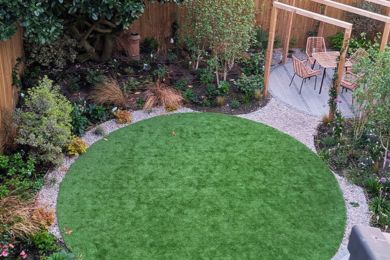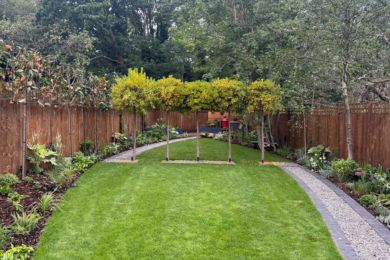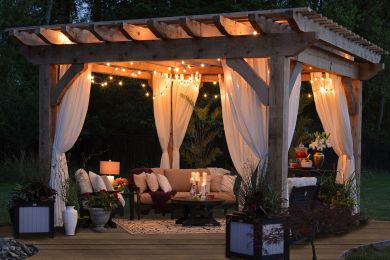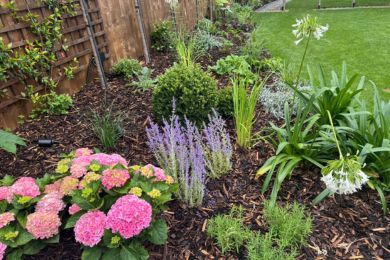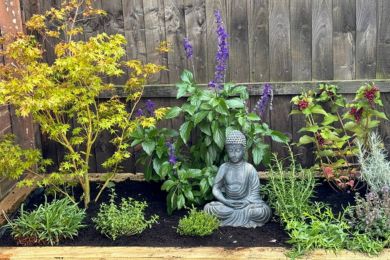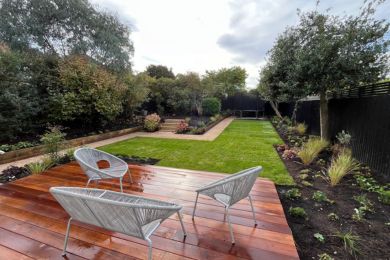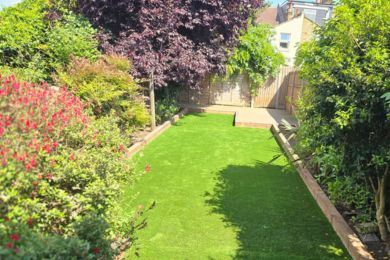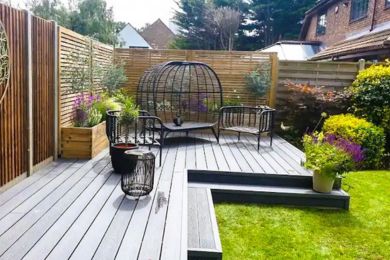Top Garden Design Trends For 2025 and Beyond
The concept of the 2025 garden is emerging as a forward-looking trend, complete with innovative design ideas, sustainability practices, and lifestyle integration. It has been an excellent year for outdoor spaces in 2025, and we can expect to see ongoing success as we approach a new year.
At SilvaTree, we believe that a well-designed garden blends artistry with ecology. With years of experience creating beautiful, sustainable landscapes, we are passionate about helping homeowners build outdoor spaces that thrive.
Using this experience and passion for garden design, we have created the ultimate guide to garden design trends for 2025 and 2025. In this post, our landscape gardeners and garden designers will provide the insights and inspiration you need to create a garden that is both on-trend and timeless
We will look at the innovative ideas shaping the future of landscaping, from high-tech solutions to a renewed appreciation for wild, natural beauty. We will also examine the enduring principles that have become the foundation of modern, sustainable design and how you can implement the current garden design trends in your own space.
The Overarching Themes Shaping Garden Design for 2025–2026
Before we explore specific trends, it’s helpful to understand the major themes influencing how we think about our gardens.
In the landscaping world, these themes have evolved and gained momentum over the past few years, shaping the way we approach landscape design.
These five pillars are driving the most significant shifts in garden design today.
- Climate Resilience: Gardens are being designed to withstand unpredictable weather and extreme conditions, from heatwaves to heavy rainfall, using adaptive plants and smart water management.
- Biodiversity and Ecology: There is a growing movement to create gardens that actively support local wildlife, serving as vital habitats for pollinators, birds, and insects.
- Wellness and Biophilia: We are increasingly recognising the connection between nature and mental health. Gardens are being designed as therapeutic spaces that promote relaxation and connection with the natural world.
- Flexible Outdoor Living: Our gardens must now serve multiple purposes, such as being offices, dining rooms, play areas, and quiet retreats. This demands clever, multi-functional garden design.
- Smart Technology: From AI-driven irrigation to advanced design software, technology is making garden creation and maintenance more efficient and data-informed.
New and Accelerating Garden Design Trends for 2025–2026
These emerging garden design trends are where the most exciting innovations are happening.
Garden designers are at the forefront, identifying and shaping these new directions in garden design trends. They reflect a deeper understanding of ecology, a bolder approach to aesthetics, and a practical response to environmental challenges.
These garden design trends also represent significant changes in how we think about and use our outdoor spaces. When considering the adoption of these innovative trends, seeking expert advice can help ensure successful and informed decisions.
Keystone Planting and Strategic Native Plant Use
The conversation around native plants has become more sophisticated. It is no longer just about using any native species; the focus is shifting to keystone plants.
These are native plants that are essential to the local ecosystem, supporting a disproportionately large number of other species, particularly insects. For example, a native oak tree can support hundreds of species of caterpillars, which in turn are a crucial food source for birds.
To use this garden design trend in your garden, first research keystone species for your region. Organisations like the Royal Horticultural Society (RHS) offer resources to identify plants that provide the most ecological benefit. Incorporating even a few keystone oaks, willows, or perennial wildflowers can transform your garden into a biodiversity hotspot.
Alternatively, you can check out our Seasonal Planting Guide, specifically for local homeowners across London and the Home Counties.
Awareness of Light Pollution and Nocturnal Ecology
As our understanding of garden ecology grows, so does our awareness of its 24-hour cycle, which impacts garden lighting.
Garden designers are now considering the impact of artificial lighting on nocturnal wildlife. Bright, cool-toned lights can disorient migrating birds, disrupt the life cycles of moths and other essential pollinators, and interfere with the natural rhythms of plants.
To implement these garden design trends ahead of the new year, ensure that throughout your garden, you are using warm-toned, low-wattage lighting.
Additional considerations to make for a sustainable, on-trend landscape include:
- Install shielded fixtures that direct light downwards.
- Use timers or motion sensors to minimise unnecessary illumination.
- Question if light is needed at all in certain areas.
For more inspiration regarding garden lighting plans and how to incorporate it into your own landscape, check out our guide here.
Maximalist and “Plant What You Love” Gardening
In a joyful rebellion against sparse minimalism, maximalist gardening is gaining traction in 2025 and 2026 alike.
This approach celebrates abundance, with dense, layered plantings that mix textures, forms, and colours. Gardeners often use different plants to create varied textures and microclimates, enhancing the garden’s versatility and interest.
Statement plants can also serve as focal points within a maximalist garden design, drawing the eye and adding personality. It’s about creating a rich, immersive experience. For more focal point ideas, check out this blog post.
These garden design trends permit gardeners to break the old rules, combining edibles, ornamentals, and natives in a vibrant tapestry. The result is a garden that feels personal, dynamic, and full of life.
Jewel-Tone and Richer Colour Palettes
Pastel colour schemes are making way for deeper, more dramatic palettes. Expect to see gardens filled with rich jewel tones in the new year, with colours like burgundy, deep plum, emerald green, and sapphire blue taking centre stage.
Plant breeders are responding with new cultivars that offer this intensity, from dark-leaved Heucheras to almost-black dahlias. These bolder colours create a sense of drama and sophistication, adding depth and richness to planting schemes.
Climate-Hardy Edibles and Foodscaping
Growing your own food is a trend with deep roots, but it is now evolving to meet the challenges of a changing climate.
Edible landscaping, which refers to the integration of edible plants such as herbs, vegetables, and flowers into garden design, combines beauty and function for a visually appealing and productive space.
Gardeners are seeking out heat-tolerant and low-water crops that can thrive in tougher conditions.
Furthermore, “foodscaping” integrates these edible plants, including fruit trees, into the main landscape design. An artichoke plant, for example, can be a stunning architectural feature, while a border of herbs adds fragrance and texture.
Incorporating edibles into the landscape represents a more sustainable approach to garden design, offering sustainable ways to garden and promoting self-sufficiency for homeowners.
Smart Tech, Automation, and AI Garden Design Trends
Technology is revolutionising garden design and maintenance, and plays a key role in upcoming garden design trends, such as:
- Smart Irrigation: Sensor-driven systems, including soil sensors, can now deliver water exactly when and where it’s needed, based on real-time weather data and soil moisture levels. This saves water and ensures healthier plants.
- AI and Parametric Tools: Designers are using advanced software to model different planting scenarios, predict how a garden will mature over time, and select the optimal plants for specific conditions. These tools allow for more precise, data-driven design.
Front Gardens and Outdoor Spaces: Kerb Appeal Meets Functionality
As we examine the most significant garden design trends emerging in 2025 and 2026, front gardens and outdoor spaces are assuming a central position. These landscapes are no longer merely an entrance threshold for your property, but a dynamic, functional extension of your residential environment. Kerb appeal is evolving beyond conventional aesthetics.
For example, contemporary front gardens are designed to be both visually appealing and purposeful, utilising sustainable gardening methodologies whilst maintaining everyday practicality.
Property owners are increasingly adopting regenerative gardening approaches and low-maintenance plant varieties to establish outdoor environments that are as environmentally responsible as they are visually striking.
By incorporating indigenous plant species, edible cultivation systems, and small-scale community gardening initiatives, front gardens can function as biodiversity centres that support local wildlife populations and pollinating species. This transition away from traditional bedding plant arrangements enables more perennial vegetable cultivation, edible flowering varieties, and abundant foliage within flower beds.
These garden design trends also provide year-round visual interest, colour variation, and textural diversity whilst reducing the requirement for continuous replanting activities.
Smart gardening technologies are also establishing prominence in 2025 and 2026, with automated irrigation systems and soil monitoring sensors enabling gardeners to conserve water resources and maintain healthy plant populations with minimal intervention.
Sustainable installations such as living walls and solar panel integration are being incorporated into garden designs, making it increasingly feasible to create outdoor environments that are both aesthetically pleasing and environmentally accountable.
Functionality represents a fundamental consideration in the current garden design trends, with outdoor culinary facilities, dining zones, and fire installation features transforming front gardens and outdoor areas into centres for relaxation and entertainment activities.
Whether you are envisioning a comfortable alcove for morning refreshments or an animated space for social gatherings, these installations add both property value and residential enjoyment. Simultaneously, elements of traditional appeal, such as natural stone boundary walls or classic planting arrangements, ensure that your outdoor environment maintains a welcoming and enduring character.
Garden Design Trends That Are Here to Stay
Some garden design trends have become so fundamental that they are now considered best practice. These are the enduring principles of modern, responsible garden design.
Landscape gardeners have played a key role in shaping a more sustainable approach, which is now widely recognised as the standard for environmentally responsible gardening.
Low-Water and Drought-Tolerant Design
Xeriscaping is no longer a niche concept, but a necessity. Designing with drought-tolerant plants and efficient water use in mind is now standard practice in many parts of the world, with a strong emphasis on conserving water as a key principle in modern garden design.
This approach creates resilient, low-maintenance gardens that look beautiful even with limited water.
Naturalistic and Meadow-Style Planting
The desire for less formal, more natural-feeling gardens continues to grow. This is expressed through soft-edged borders, wildflower meadows, and a willingness to let certain areas of the garden grow a little wilder, encouraging the benefits of growing plants in a more naturalistic, less controlled manner to promote resilience and biodiversity.
These garden design trends, popularised by designers like Piet Oudolf, create a sense of movement and connection to the wider landscape.
Permeable Hardscapes and Sustainable Materials
Impermeable surfaces like concrete contribute to water runoff and urban heat islands, increasing the risk of flash flooding.
The use of permeable paving, gravel, and recycled materials is becoming a baseline requirement for sustainable hardscaping. These materials allow rainwater to soak back into the ground, replenishing groundwater and reducing strain on drainage systems.
Incorporating rain gardens alongside permeable surfaces offers an innovative solution for managing stormwater and promoting ecological health.
Container and Vertical Gardening
In an increasingly urbanised world, space is a luxury. Container and vertical gardening allow anyone to create a lush garden, no matter how small their space, and make it possible to grow different plants by utilising containers and vertical structures.
This garden design trend is about using every available surface to add layers of green, from balcony pots to living walls.
Supporting Wildlife and Pollinators
What was once an optional extra is now a core design principle. Creating habitats for pollinators and other wildlife through pollinator strips, habitat corridors, and insect-friendly planting is essential for ecological health.
A modern garden is incomplete if it doesn’t actively support the local ecosystem. The gardener plays a crucial role in fostering these habitats, ensuring that both ornamental and edible landscapes benefit wildlife and pollinators.
Various plants can be incorporated into these landscapes, as explored in our Best Plants For Wildlife-Friendly Gardens post.
How to Adopt Garden Design Trends
It can be tempting to jump on every new trend, but the most successful gardens are those that are thoughtfully curated. Before adopting a new idea, ask yourself:
- Does it fit my climate and site? A xeriscape design won’t work in a damp, shady garden.
- What is the maintenance commitment? Be realistic about how much time you can dedicate.
- Does it provide an ecological benefit? Prioritise garden design trends that support biodiversity.
- What is the long-term value? Invest in changes that will endure and add lasting value.
A trend-savvy refresh often starts with a planting plan or seasonal re-assessment, which SilvaTree can provide to align your current space with the latest design direction. For tailored solutions and to make informed decisions, seek expert advice from our experienced team.
A great way to experiment is to start small. Pilot a new idea in one corner of your garden, like a small pollinator-friendly planting or a single container with a jewel-toned colour scheme. See how it works before committing to a larger overhaul.
Conclusion
The garden design trends for 2025–2026 point towards a future where our gardens are more beautiful, resilient, and ecologically vibrant than ever before.
By blending new innovations with enduring sustainable principles, we can create outdoor spaces that truly thrive. Creating spaces that reflect your personal style and needs is at the heart of these emerging trends.
Whether you are inspired to create a biodiversity hotspot with keystone plants or design a chic, low-water outdoor living area, the possibilities are endless. In particular, features like statement houseplants and heirloom seeds are taking centre stage in garden design trends for 2025–2026.
If you’re ready to transform your garden, SilvaTree can help. Our expert team can guide you through the latest garden design trends and help you create a sustainable, modern outdoor space that is perfectly tailored to you.
Contact Us Today
Contact us today for a design consultation, and let’s start building your garden of the future.
Frequently Asked Questions
How do I know which garden trends are right for my space?
Not every trend fits every garden. The key is to consider your local climate, sun exposure, and maintenance preferences. For example, a drought-tolerant landscape might be perfect for hot, dry regions, while shaded gardens may benefit from layered, biodiversity-friendly planting.
At SilvaTree, we help homeowners match garden design trends to their environment, ensuring both beauty and sustainability. For personalised recommendations tailored to your needs, consider consulting a landscape architect or garden designer who specialises in sustainable and climate-conscious garden spaces.
Are sustainable garden designs more expensive to create or maintain?
Not necessarily. While the initial setup (e.g., permeable paving or smart irrigation) can cost a bit more, sustainable gardens often save money long-term through reduced water use, lower maintenance needs, and greater plant resilience. Integrating interior design principles into your outdoor space can also enhance the connection between your garden and your home’s overall style.
What’s the easiest way to update my garden for 2025–2026 trends without a full redesign?
You don’t need to start from scratch. Small updates, like adding keystone plants for wildlife, introducing climate-hardy edibles, or using warmer, low-impact lighting, can bring your garden up to date.
A trend-savvy refresh often starts with a planting plan or seasonal re-assessment, which SilvaTree can provide to align your current space with the latest design direction.
